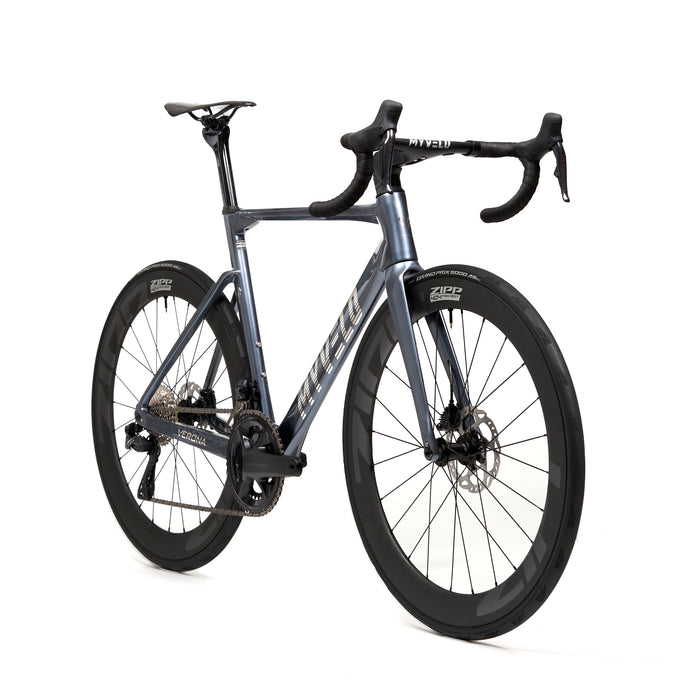
Verona road bike
incl. FREE shipping & free returns

If you are serious about racing bikes, there is one material you cannot ignore: carbon. Hardly any other material has revolutionized the world of cycling as much as this one. But what exactly makes carbon so special? And is it really worth investing in a carbon racing bike? In this article, we will look at the most important aspects that you should consider when choosing a racing bike with a carbon frame.
Von Fabian Huber |
4 minutes read time

Carbon, or more precisely carbon fiber reinforced plastic (CFRP), consists of thin carbon fibers that are processed into a strong yet lightweight material. The way the fibers are woven and bonded with resins allows the stiffness and flexibility of the frame to be controlled very precisely.
What makes carbon so attractive for you as a road cyclist is the combination of lightness, stiffness and adaptability. A carbon frame is usually significantly lighter than an aluminum or steel frame, which makes a noticeable difference when climbing and accelerating. At the same time, carbon offers high stiffness, which efficiently converts your power into speed. This is particularly advantageous during intense sprints or steep climbs.
The advantages of a carbon racing bike are obvious:
Lightness: Carbon road bikes are among the lightest on the market. The lower weight means you have to use less energy to get the bike moving - you'll especially feel the difference on climbs.
Rigidity: The rigidity of a carbon frame ensures that no energy is lost. Every watt you put into the pedals is converted directly into propulsion. This is particularly noticeable on flat stretches and when accelerating.
Comfort: Carbon frames have the ability to absorb vibrations. On longer rides, you will appreciate the comfort of such a frame as it can absorb bumps in the road better than conventional aluminum frames.
Aerodynamics: Since carbon can be made into almost any shape, manufacturers have the opportunity to develop particularly aerodynamic frames. This property is particularly useful at high speeds when you want to minimize wind resistance.
As tempting as all these advantages sound, there are of course some aspects that you should consider when deciding on a carbon racing bike.
Costs: Carbon frames are more complex to manufacture and more expensive than frames made of aluminum or steel. If you want a high-quality carbon racing bike, you should be prepared to dig deeper into your pockets.
Sensitivity: Even though carbon is a very durable material, it can be damaged by strong impacts or accidents. While an aluminum frame can take a dent and still be usable, a carbon frame can crack in an accident. Regular inspections for cracks or other damage are therefore particularly important.
Repair costs: If a carbon frame is damaged, the repair costs can be significantly higher than for a metal frame. In some cases, repairs are not even possible and you would have to replace the entire frame.
The question of whether you need a carbon road bike depends on several factors. Are you an ambitious racer who wants to get the best out of yourself, or do you ride mainly for fun and fitness?
Ambitious road cyclists: If you are looking for performance and every second counts, a carbon road bike is definitely the right choice. The combination of lightness, stiffness and aerodynamics can help you improve your personal best times.
Recreational riders: Even if you ride mainly for fun, a carbon road bike can be a great option. The ride comfort and lower weight ensure a pleasant riding experience even on longer rides. However, you should think carefully about whether you are willing to accept the higher price and the slightly more sensitive handling.

While carbon is undoubtedly the first choice in the professional sector, frames made of aluminum or steel also have their place.
Aluminum: Aluminum frames are often a bit heavier than carbon frames, but they also offer high rigidity and are less expensive. For beginners looking for a robust and affordable road bike, aluminum is a solid choice.
Steel: Steel frames are particularly durable and offer a pleasant, smooth ride. However, they are heavier than aluminum and carbon frames, which is why they have become rather rare in the racing bike sector. However, steel frames are still an option for nostalgics and lovers of classic bikes.
The carbon market is constantly evolving. Frames are being produced that are becoming lighter and at the same time more stable, and manufacturers are experimenting with new manufacturing techniques to achieve even better riding characteristics. One of the latest examples is the MYVELO Verona , a racing bike with a carbon frame that is at the forefront in terms of both lightness and aerodynamics. It shows how far the technology has already progressed and what possibilities carbon opens up in racing bike construction.
Another trend that is emerging is sustainability in carbon production. Since the production of carbon frames is resource-intensive, some manufacturers are working on recyclable carbon materials or making efforts to make the production process more environmentally friendly. Some manufacturers are working on processes to reuse old carbon fibers, thus closing the material loop. These recycled fibers are then used in new frames or other products, reducing the environmental footprint. Efforts to make production more efficient and resource-saving are also increasing. In the future, this could mean that carbon road bikes will not only be high-performance, but also more sustainable.
A carbon road bike offers numerous advantages, especially if you value lightness, stiffness and riding comfort. It is the first choice for ambitious riders who want to get the most out of their performance. However, if you ride mainly for fun or your budget is limited, you should also consider other materials.
At the end of the day, it all depends on your priorities and how much you are willing to spend on your road bike. With a carbon road bike like the MYVELO Verona , you are well equipped when it comes to taking speed and comfort to a new level.
Get advice from cycling enthusiasts

Als Rennradfahrer möchte man möglichst ständig besser werden: schneller, ausdauernder und effizienter. Doch was, wenn der Schlüssel zu diesen Zielen nicht nur auf zwei Rädern liegt? Rudern, oft unterschätzt, bietet eine ideale Ergänzung zum Radtraining. Es trainiert nicht nur den ganzen Körper, sondern verbessert auch die Ausdauer, Kraft und Stabilität – entscheidende Faktoren für jeden Radsportler.

Nach einer intensiven Rennrad-Einheit ist die richtige Regeneration entscheidend, um Leistung zu verbessern, Verletzungen zu vermeiden und langfristig Fortschritte zu erzielen. Doch wie sieht eine effektive Erholung aus? Hier bekommst Du die besten Tipps zur optimalen Regeneration nach dem Rennradtraining.

Erfahre, wie Radsport-Ligen aufgebaut sind und weitere Infos zur Organisation im Profi-Radsport!